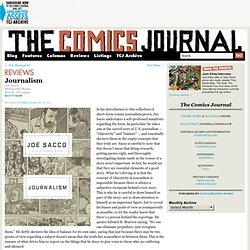

Journalism. In his introduction to this collection of short-form comics journalism pieces, Joe Sacco undertakes a self-professed manifesto regarding the form.

In particular, he takes aim at the sacred cows of U.S. journalism — “objectivity” and “balance” — and essentially skewers them as the empty concepts that they truly are. Sacco is careful to note that this doesn’t mean that doing research, getting quotes right, and thoroughly investigating claims made in the course of a story aren’t important. In fact, he would say that they are essential elements of a good story. What he’s driving at is that the concept of objectivity in journalism is impossible because there is always a subjective viewpoint behind every story. This is why he is careful to draw himself as part of the story: not to draw attention to himself as an important figure, but to reveal his biases and point of view as transparently as possible, to let the reader know that there’s a person behind the reportage.
Joe Sacco’s “The Great War” Joe Sacco’s latest work, “The Great War,” a twenty-four-foot-long panorama that folds like an accordion, illustrates the first day of the Battle of the Somme, one of the bloodiest battles in history, which took place on July 1, 1916.

The Maltese-American cartoonist is best known for his comics journalism, including works like “Palestine,” “Safe Area Goražde,” and “Days of Destruction, Days of Revolt” (his 2012 New York Times best-selling collaboration with Chris Hedges), but “The Great War” is a purely visual work, homing in on a specific moment in history. We spoke with Sacco about his approach. When I got a call from an old friend of mine, an editor at Norton, asking me to draw a panorama of the Western front, my first response was “No!” Being a cartoonist, I always think in terms of narrative—but I grew up on Australia, and there the First World War truly gives Australians a sense of national identity. I don’t feel a separation from the people I read about in history books. Chris Hedges and Joe Sacco: drawing America's invisible poor - audio slideshow. Joe Sacco's Great War graphic tableau becomes giant Paris metro poster.
Joe Sacco's epic, 24-ft-long depiction of the first day of the battle of the Somme has been recreated on the wall of the Paris metro.

Published last autumn, the acclaimed cartoonist's wordless panorama The Great War picked out the events of the first world war battle, which began 98 years ago on 1 July, from the British soldiers who went over the top, to the mass burials of the dead. It drew glowing reviews on publication. Steve Rose called it "a cross between Hergé and the Chapman brothers; the Bayeux Tapestry as a silent movie" in the Guardian.
Sacco himself has said the work was inspired by the Bayeux Tapestry. "It all started when I was playing darts with a friend of mine in New York," he told AFP. Now the comic is being shown in the Montparnasse metro station in Paris in a display which runs to 130 metres. He told Le Monde that the fresco was trying to show "the scale of what happened that day". Interview. In his books, Joe Sacco always draws himself the same way: neat and compact, a small bag slung across his body, a notebook invariably in his hand.

At a single glance, the reader understands that he is both reporter and innocent abroad, an unlikely combination that propels him not only to ask difficult questions, but to go on asking them long after all the other hacks have given up and gone home. You sense in this black-and-white outline, too, a certain taut, physical alertness. Should there be trouble, he is, it seems, ready to run.
The expression on his face, however, is more difficult to read. Sacco keeps his eyes permanently hidden behind the shine of his owlish spectacles; anyone wishing to gauge his deeper emotions must rely instead on his bottom lip. Is his eyelessness intended to send some kind of subtle message regarding the reliability of the reporter-narrator? Thanks to publishing hyperbole, writers often get called "unique".
He shrugs. In 2003, he went back.